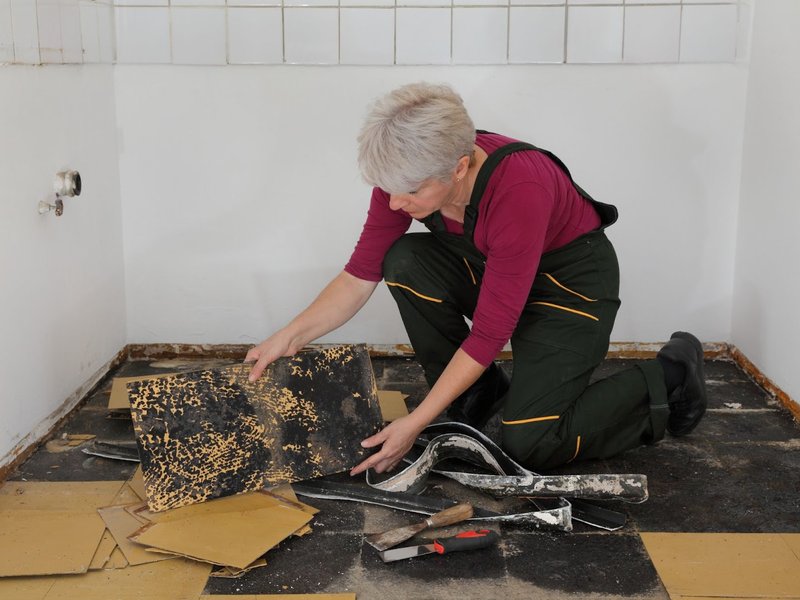
The rich textures and soundproof designs of vinyl flooring sure do an incredible job of elevating one's home appeal. However, like all amazing things, vinyl floors also have a limited lifetime. The scratches and rough use in high-traffic places cause the vinyl floor to break down after several years.
Now, the only sensible option you can go for is to remove the vinyl flooring altogether and install a fresh new layer.
Wondering how you can remove vinyl flooring and deal with glue residues with minimal effort? Let's find out!
How to Remove Vinyl Flooring?
Removing vinyl flooring is quite a straightforward task. You can even finish the job yourself if you have little understanding of how to use the various tools. Here are the specific tools you'll need to perform the job:
Tools
- Utility knife
- Adhesive strippers
- Heat gun
- Floor scraper
- Wood saw
- Flat pry bar
- Power scrapers
Gear
- Work gloves
- Goggles
- Wood Block
- Coveralls
Let’s now move on to the stepwise guide to remove the vinyl floors seamlessly.
Step 1: Assess the Floor Area
First, you need to inspect the vinyl floor type in your home. It's essential because asbestos vinyl floors were prominent until 1980. Asbestos-containing materials are harmful, and even the little asbestos fibers can lodge into your lungs, leading to cancer-related medical implications.
You don't want that, right? So, inspect your flooring first and carefully deal with asbestos vinyl floors. Here's how you can identify such vinyl flooring:
- Find out the date of vinyl floor construction
- Check out the size. Usually, asbestos has three dimensions: 9 x 9, 12 x 12, and 18 x 18
- Asbestos tiles have asphalt, which can cause discoloration on the subfloor
Step 2: Remove Baseboards and Round Trims
Your floor must have round trims and baseboards on the floor corners. So, remove them using a pry bar. First, use the utility knife to cut the layer of paint that connects your trim and your baseboards, then penetrate the pry bar into the trim and baseboard joint point, and then gently strike it using a hammer. Now, slowly pry away the trim and proceed along the wall.
Additional tip: Before starting, move the furniture or any hurdle from the floor to avoid any disruption when removing the vinyl tiles.
Step 3: Start Cutting From the Center
Vinyl sheets/tiles are easily penetrable using a simple utility knife or razor. Vinyl floor is usually glued only from the perimeter corners of the floors, and it is laid loose in the center, so start cutting the floor to be removed from the center.
For sheets, start cutting from at least 8 inches from the wall and see if you can easily pull up the sheets. For tiles, peel up a corner and scrape or pull up the tile from there.
Step 4: Cut in Strip Form
To make the removal process manageable, cut the vinyl sheets into strips with a width of no more than 12-15 inches. Although you might find it tempting to pull large sheets of vinyl, this approach makes vinyl heavy and challenging to manage. So, get your utility knife and slice the sheets into narrow strips and simultaneously use your hand to pry off the strips.
Step 5: Remove The Glue From Vinyl Floors
Of course, there will be several regions where stubborn adhesive may make it too complex to remove the vinyl from the subfloor. Don't fret. Here are plenty of ways to strike off the vinyl effortlessly:
- Heat Gun: It's ideal for loosening up the dried stubborn adhesive. Turn it low and wave it over the flooring and underlayment to soften the glue. Use a scraper after that to remove the sheets.
- Pry Bar: Hard scraping works best when the flooring is softly glued. Use the tip of the pry bar and chisel it under the vinyl to separate it from the subfloor.
- Power Scrapers: The powerful blade cuts directly into the vinyl flooring, ensuring the job gets done faster.
- 5-in-1 tool: The sharper blade cuts through the hard surface and removes the vinyl sheets efficiently.
Step 6: Clean Up The Area
After removing the sheets, you'll find several glue patches on the subfloor. Well, it's best to remove it if you're planning to install new vinyl flooring. Several adhesive strippers tools and techniques to abolish the excess glue residues include:
- Superheated Water
If you are removing vinyl from a concrete floor, heat the water to the boiling point and pour it onto the floor. The adhesive will turn soft after a few minutes, and you can thereby scrape it using a spatula or pry bar. Using this method on a plywood, or other porous subfloors may cause water and mold damage.
- Heat Gun
On hard surfaces that are not impacted by heat, such as concrete, you may also use a heat gun to soften the adhesive prior to scraping.
- Warm Water Solution
Create DIY adhesive strippers using warm water and soap in a bucket. Apply it to the hard adhesive and allow the mixture to soak the glue. After a while, the adhesive will soften, which can be removed easily.
- Acetone based Adhesive strippers
You can create an acetone mixture and spray it onto the glue residue. Wait for the mixture to dissolve the bond and push the glue away using a scraper.
If any stubborn spots of adhesive remain, you may use a heat gun to soften the adhesive and then scrape, or gently use an electric sander. Finally, dump the vinyl scraps into trash bags and cans as per the local dumping rules. Now, vacuum and clear the subfloor for the next layer installation. If you want to learn about different designs that suit the area, contact Carpet Warehouse for expert guidance.
Frequently Asked Questions (FAQs)
How to remove glue residues from vinyl flooring?
It's a high chance that you may accidentally spill glue on a vinyl floor. In case the glue is fresh, use a damp cloth to clean off the residue. For excess glue, gently use a scraper and then finish rubbing it with a disposable rag.
If the glue has dried, use adhesive strippers like acetone or a heat gun to soften the glue and then gently scrape it.
What are safety considerations when removing vinyl flooring?
Here are several essential pointers to consider when removing vinyl:
- Hire a professional when removing asbestos vinyl floors.
- Heat guns can be dangerous. Avoid using it in front of flammable material.
- If you remove using your hands, ensure you correctly remove the vinyl layer from the subfloor instead of only the backing layer.
What's the procedure to remove vinyl from a plywood subfloor?
The removal process is the same whether it's concrete, plywood, or hardwood subfloor. Start with a knife to penetrate the vinyl layer, and use a scraper to lift and then pull the flooring. If you’re stuck with glue, use acetone-based adhesive strippers to eradicate the glue patches.
Parting Thoughts!
Vinyl floor removal is indeed an easy-to-follow process. Follow through our six-step guide and use suitable adhesive strippers; rest assured, you'll finish the task within a few hours. Now that you have decided to remove the vinyl flooring, you might be thinking of adding a new floor layer. Isn't that true? To make non-regrettable decisions, reach out to Carpet Warehouse for consultation regarding top flooring designs. We ensure here you'll get some high-quality vinyl flooring options that elevate your home's appeal like never before. Get in touch today!

